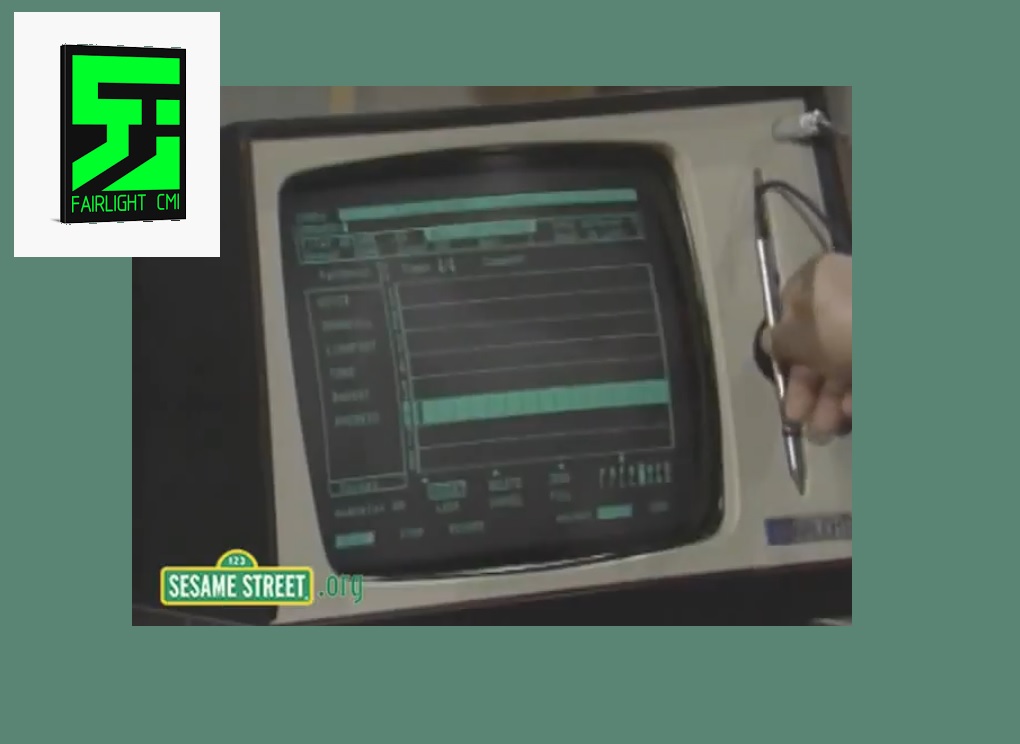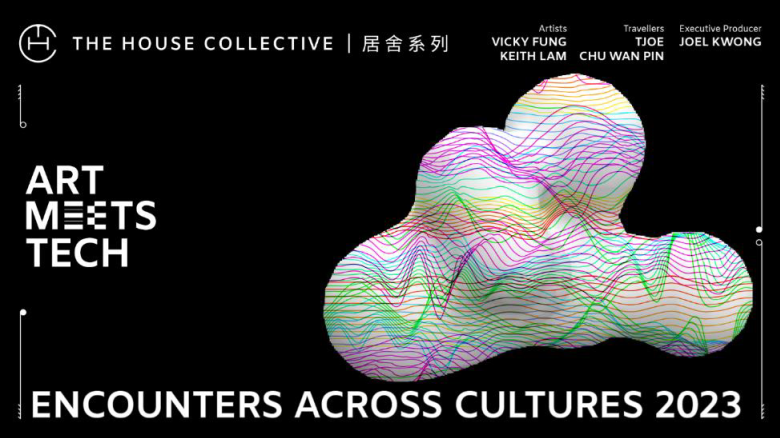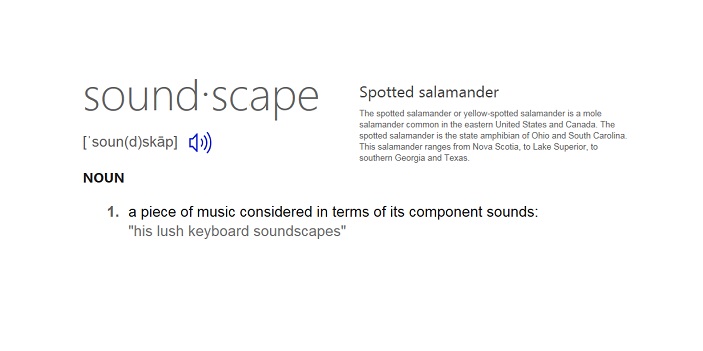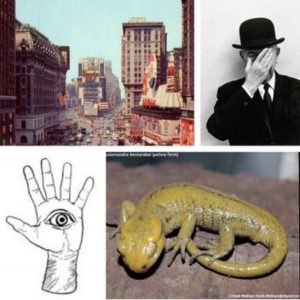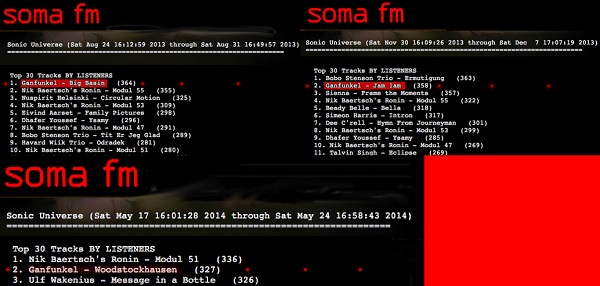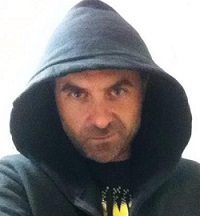Clive Smith – recording artist, composer, performer, sound designer
You might have heard him on the soundtrack for the ’80’s cult film Liquid Sky. You might have come across his name on a whole lot of session-work and collaborations. Clive Smith, often credited as the ’Fairlight Programmer’. And you can see him below on the legendary 1983 Sesame Street-episode, in which Herbie Hancock is demonstrating the Fairlight. But that’s just the tip of the iceberg…
Whether it is your typically structured mainstream music, or the more textured, experimental kind: Clive Smith morphs fluently between both realms. “I’ve always been interested in texture, as well as in structural music composition.” He started out as a trumpet player in high school, is a trained musician and has taught himself to play guitar, bass-guitar and keyboards. “Those sparked to me a lot more. The trumpet, it never really sat with me as well as the ’rock instruments’. But occasionally, I pick up the trumpet to keep my lips in shape, or to play it on some album. When I went to university, i took a multimedia-course, which was basically visual arts and sonic arts.
There was a VCS3, the ’Putney’, and I really fell in love with synths and the ability to create and craft your own sounds; to manipulate them. I was always interested in electronic sounds. Prior to the synths, I used tape. My father had an expensive tape recorder. I used to have lots of fun with it, recording all sorts of sounds, noises, trying to play it backwards.” He reckoned how John Lennon discovered that by accident. “I was very interested in those kind of things. “
Becoming the Fairlight expert
Clive came fresh out of college with a degree in musical composition. But… What to do next? ”One of my professors started this non profit organisation called Public Acces Synthesizer Studios. I started out as the associate director and later, I became director. In 1980, there was an Audio Engineering Society convention in New York City. There was this Australian company called Fairlight, showing this instrument; it was probably one of the first times it was shown in the US. Back then, it was just called the Fairlight CMI, for there were no Series II, IIx, etcetera yet. I was amazed by it. It took a little bit of doing, but the following year, we had one at PASS, on loan to us.
I fully immersed myself in it, trying to learn as much about it as I possibly could. The great thing was, there were no specific rules on how to use the instrument. I took lots of time sampling and creating my own sounds and I thoroughly enjoyed the fact that there weren’t any boundaries someone else already had defined. That was extremely satisfying. ”
“As soon as I learned everything about the Fairlight, this Russian director, Slava Tsukerman, came in at PASS, as he wanted to create the soundtrack of what later would become Liquid Sky. He realized he couldn’t operate this computer himself, so he initially hired Brenda Hutchinson, who started working on the project with him. She was called away for a job on the West coast. So I took over and did the remaining two third of the project. I think there were three or four different types of classical pieces that the director came to us with.’ They programmed that into the Fairlight. You might call that a hell of a job.
Clive: ‘It was very much like old-fashioned computer programming, using a code for every note, every change, like velocity or note durations.” At that time, there was only the Series 1. So, no easy peasy sequencing, using Page R, which was introduced into the Series II, in 1982. ”There were two types of recording. The first one was non-real time, using Musical Composition Language. The second method was called Page 9. It recorded in real time, but there were no visuals; you couldn’t really see what you were doing on the screen. When you made a mistake, you had to start all over again.”
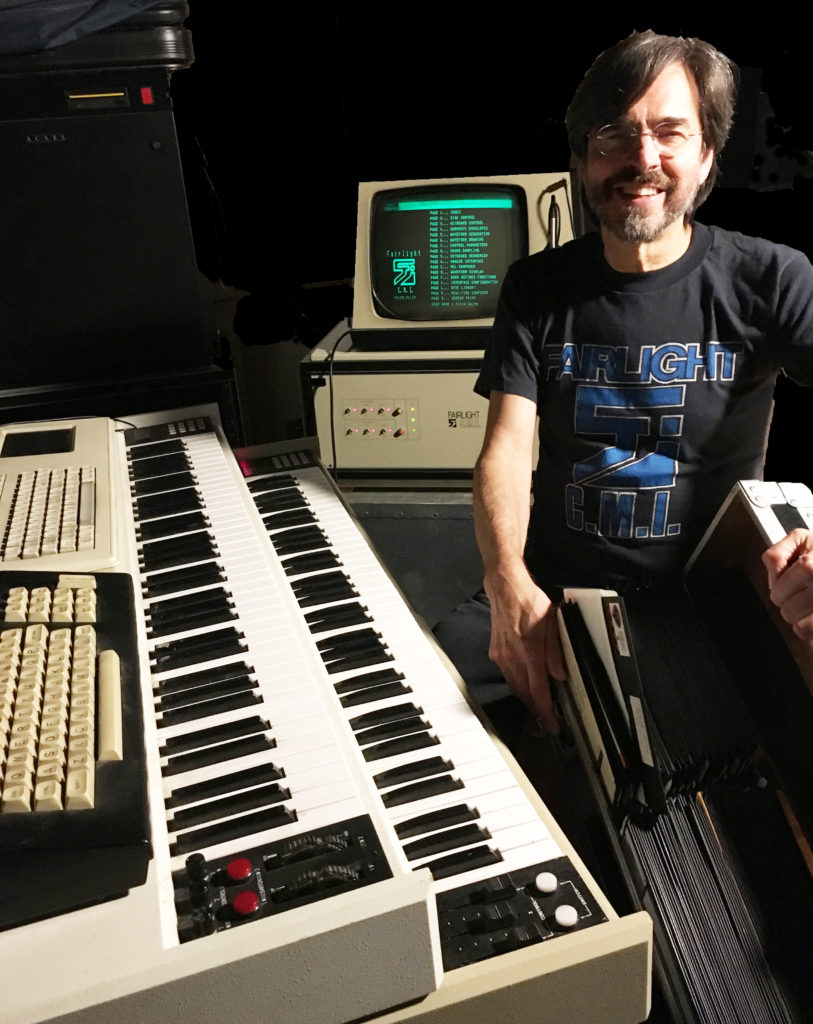
Quick and dirty
“Slava isn’t a musician himself. But he did have musical ideas and a clear vision of what he had in mind for the soundtrack. He’d just tap a rhythm, or hum a melody, moving his arms in a particular way, saying: “I want this for that scene.” And I would just play around with some ideas. When there was something he liked he said: “OK, let’s record this.” We’d immediately be recording the ideas, right when they were fresh. Often, I wanted to do it again, for I thought it was too sloppy. I wanted to go back, perfecting it. But then he‘d say: “No, I like it. Let’s make it quick and dirty.” He liked the sort of clunkiness; the marriage between the computer high tech and the punk approach.
I had sampled lots of different percussive sounds. Some wooden, metal and glass wind chimes. I put them all together, and I think that’s what we ended up using for the creature sounds. They weren’t specifically made for the movie. I played it to Slava, he liked it. They fitted with his vision for the movie. So they ended up being part of the alien sounds.
Brenda had seen some of the footage. When I started working on it, I never saw any footage. So it was only his verbal description of things. So in a way, I wasn’t influenced at all by visuals. I was strictly translating what he was conveying to me. It wasn’t until the actual premiere that I saw how it all worked together. And it worked very well. Me and Brenda, we got the credits for composing, but it was his vision. He was coming across with moods. I only matched with what he was doing. And if he would have let me be alone with it, it would never have turned out that way.”
Rocking it on Sesame Street
Because of Liquid Sky, the US branche of the Fairlight company asked if he would work for them. He left PASS and became one of their consultants, from 1983 ’till about 1989. Clive: ”That was incredibly great. I had access to the equipment, I promoted their product doing demos, and I was doing session work on the side.” So, how did he end up with Herbie Hancock on Sesame Street? Clive: ”Alexander Williams, he did sort of what I was doing, on the West Coast. When Herbie Hancock purchased his Fairlight, he had Will training him on how to use the machine. When he wanted to capture his ideas, in a session, on the fly, Will was able to help him out with the technical side.
When Herbie visited the East Coast, I kind of did the same thing for him. Will and I knew each other, and it turned out Herbie and I had some mutual friends. So, that worked out nicely. I think, if I remember correctly, Herbie didn’t travel with his Fairlight, so he used mine for the Sesame Street-session. The show went pretty much as shown; the children were very excited about this new technology. Just like the kids are today. We didn’t do anything different. That clip was pretty much the entire take.
People were always very curious about it. And It’s very inviting; something that looked like a ‘60’s tv-screen, a bit of a retro sci-fi-look, a huge white keyboard, playing melodies with barking dogs… It looked accessible, more ‘friendly’ and less intimidating than a modular synth with patch chords, knobs and sliders.”

“I’m really glad I got the opportunity to work with Herbie Hancock. Up until then, I never realised what an amazing musician he is. It was great to see the ideas running in his brain, coming out. Always, his first ideas were immediately great. Watching him listening to a musical piece he’d never heard before and then, coming up with this great keyboard part. Very enlightening to see. And he’s a very nice, very friendly down to earth kinda person.
You know, formally trained musicians often want to play tunes on a synth using their keyboard technique. Herbie, he was very open to coming up with interesting sounds, being Interested in things that had some internal movement on the things he was playing. I think, that’s what we have in common: having this split personality between being a trained musician, using structured forms, and being able to work with textures, creating sounds, the approach a non-musician might have. The more creative approach by just going in and thinking: ’What would i like to happen?’.
Big bam boom
In 1984, I bought my own IIx; that’s when the session work really took off. In ‘86, the series III was released and I was able to purchase one fairly early in its existence. There are certain things that are unique to the IIx, but I could do so much more on the III. It expanded on the things I wanted to do. I started using them both.” And so, he was moving around New York, carrying around two fairly heavy machines. ”I was doing a lot of session work in New York, mostly in the avant-garde music scene. I was either playing in progressive rock bands, avant-garde rock bands or free jazz and noise bands. And all of a sudden, I was called in to do sessions with very mainstream artists. There was this buzz going ‘round about the Fairlight. People were looking for that extra spice to add to their music. So, I was hired to make a few noises on the track.” Laughing: ”It felt a bit like being the odd one out.”
In 1984, he was asked to work on the Hall & Oates-record Big Bam Boom. “They were listening a lot to Sgt. Pepper’s. They wanted to take a different approach. They didn’t want to emulate The Beatles, but it was the whole idea that they needed to break out of their old approach and treat the studio in a different way, instead of archiving and capturing what they did playing live. That was essentially what it was. That’s why they brought in the Fairlight. They didn’t know exactly what it did, or what they thought it would do. But they might have thought it could be the ingredient pushing them into a new era. Of course, they did the pop music that they were known for, but in a slightly different way and I think it was successful. Their new approach did work out for them.”
“They didn’t have all the songs written yet; just some words, some of the choruses were done. A lot of things were formed in the studio. The way I worked with them was a little unorthodox. Next to the control room, in the Electric Ladyland studios, there’s the vocal booth. They took the door off that separated the booth from the control room. And they’d have me set up with the Fairlight and some speakers, letting me hear the same play-back the producer, Bob Clearmountain, was hearing.
They had me playing along with the music and every now and then they’d listen to what was coming out on my channel; what I was coming up with. When they liked it, they decided to put that on the record. I’d put something in, or Robbie Kilgore, the other keyboard player they hired. That’s how we worked for about three months. It was done very professionally, almost like a regular nine-to-five job. At 10 am, we’d come in, we’d have a short lunch break, and around 6 pm we were usually out of there. No drinking or drugs were allowed in the studio; they were very disciplined, especially Daryl. It was a very instructive experience and it got me a lot of jobs at sessions. It was a great opportunity.“
Programmer? Keyboard player?
On album credits, guys like Clive were often referred to as ’Fairlight programmer’. Which makes you think: didn’t he play some decent notes at all on all these records? Clive: “They didn’t know what to make of it, so they called it Programmer. Which was fine with me. The lesser known music I worked on was where I got to play more. On some of those, I even play the guitar. People brought me in as the Fairlight programmer, but then they learned I play keyboards and guitar as well. So often, they’d ask: ’Oh, you play guitar? Bring yours tomorrow!’ and they’d let me lay down a couple of tracks as well.
Right before the final days of the series III had arrived, before the original Fairlight company went down, I had a midi guitar. I used to bring it to sessions, so I could play the Fairlight from the midi guitar. That was great, because I was able to do things I couldn’t do on the regular keyboard. Especially when it comes to bending pitches in a particular way; that sort of thing. Each string could have a different sound to it. So with the midi guitar, in a way, you had six keyboards with different sounds attached to each string. Sometimes you ended up with some very wonderful things. I’ve used that on the more obscure records, because people were more open to try different things than they were on mainstream recordings.”
Shaping and creating
Over the past few years, Clive has worked on many, many projects, providing music, or musical textures for a dozen tv-shows, doing session work, being a sound designer for Korg… And today, he’s working on a variety of interesting collaborations. ”There’s always something going on.vAt the moment, I’m doing sounds for PARMA. They approached me, because they liked a particular piece I’ve made in the past. So they asked if I had any more material like that. I’m actually working on that at the moment. I’ve finished about 25 minutes of music for it. And it will probably be 50 minutes, so I’m halfway through.
It’s fairly textural material, but tonal at the same time. Recently, I’ve become very interested in this composer Arvo Pärt who’s been around for a long time, but I became familiar with his work just recently. Some of the things I was touching on are similar to what he’s been doing for years. It inspired me to go further down this particular path. It almost felt as if we were aligned in some way. So, that’s the direction this particular suite of pieces is going to.’
“I’ve always been interested in texture. There is something about texture in the visual realm as well as in the sonic realm that I love. Getting inside of a sound, reconstructing it. With the textured soundscapes, I feel it’s communicating more directly with your subconscious. That’s the impact of art and music combining. It reaches you in ways that are difficult to articulate. it’s just… telling you a specific story.”
One of the other things he’s been working on, is archiving some of his older Works. “I recently uncovered some recordings from the early days of the Fairlight, and I also recovered some old tapes. I’m trying to transfer them into ProTools, before I lose acces to it, not being able to play these things back. I discovered some unfinished things that I made. I might revisit them. I work on those things which strike me the most at that time, in between the session work I do.”
There’s no time like the present
Of course, there’s just one question left: does he still use his Fairlights? Clive: ”Unfortunately, my Series III is not completely operational right now. But I will probably be able to use it again very soon. My IIx on the other hand is completely functional. That is, everything except for the light pen. But, I don’t really need the light pen anyway.
Even today, when I purchase new hardware or software, it always comes down to: does it excite and inspire me in some way? Just because it’s new doesn’t mean it’s great. It has to surprise me. But, the other way around: I do have some vintage guitars and I like them. Not because they’re vintage, it’s because I have built a relationship with them over time.
I don’t want to be locked into a specific time-period. So, to me, it’s not about a specific age or about nostalgia. Having said that: the Fairlight grabbed me in a way that no other instrument did before that. And I do still love them.”
For the Silo, Mirjam van Kerkwijk. Read more from Mirjam about the revolutionary Fairlight here: http:// www.fortheloveofthefairlight.com or here: https://www.thesilo.ca/tag/fairlight-cmi/.
